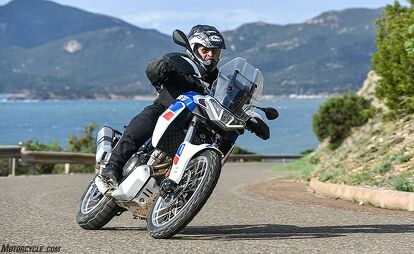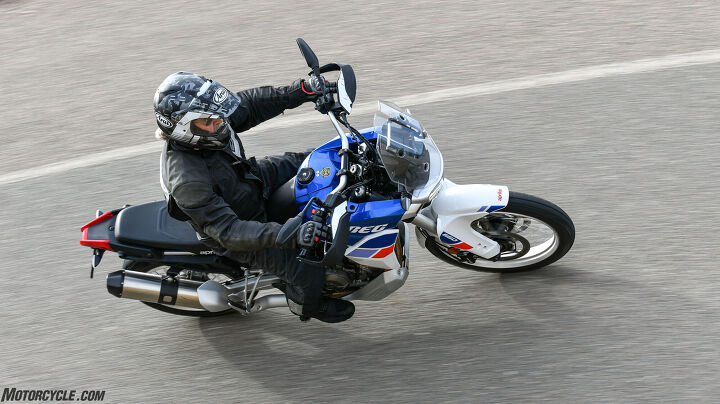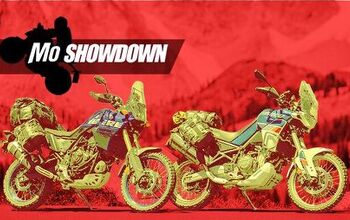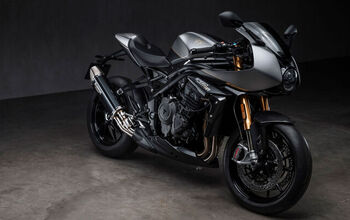2022 Aprilia Tuareg 660 Review – First Ride
"Imohag" is Tuareg for "free men"
The main beauty of Sardinia is the almost complete lack of Sardinians, which makes it hard to explain why the twisty roads that connect the villages on the Mediterranean’s second-biggest island are so perfectly maintained. The new Aprilia Tuareg 660 is up for all of them. There’s a lot of second and third gear work in there, which the optional quickshifter makes quick work of, and even the occasional first-gear corner when the fur is flying – also not a problem.
2022 Aprilia Tuareg 660
Editor Score: 91%
| Engine | 18.5/20 | Suspension | 14/15 | Transmission | 8.5/10 |
| Brakes | 8.5/10 | Instruments | 4.5/5 | Ergonomics | 9.25/10 |
| Appearance | 9.25/10 | Desirability | 9.25/10 | Value | 9.25/10 |
+ Highs
- A serious yet playful adventure motorcycle
- Near-perfect balance of power and lightness
- Good looks and great sound too
– Sighs
- You won’t get to carry tire irons and tubes around
- No more use for your cheap mechanical throttle lock
- Your orthopedist will be sad you don’t need that hip replacement after all
Most bikes with 21-inch front wheels are excused from possessing really sporty pavement cling, but the Tuareg and its Pirelli Scorpion Rally STRs are having none of it. Feel free to shove its beak-free nose deep into the corner; it sticks fine, something to do with light weight and the distribution of it, and when either tire starts coming loose you can feel and control it: You’ve got 4.8 gallons, or 30-ish pounds of fuel on board, but most of it’s low and between your calves. Also, the cylinder bank has been rotated about 10 degrees rearward compared with the street 660s. The more vertical cylinder bank further reduces the yaw movement of the bike, boosting its agility in tight turns. Where the fuel normally goes there’s a big airbox which seems to have an angry goose trapped inside when you roll the throttle on hard, which you find yourself doing a lot.
Tuned for torque
But it’s not a goose; it’s for me the best iteration so far of the 660 cc parallel Twin Aprilia has stuck twice before into the RS660 and Tuono 660. Both are great bikes, but both have a bit of a dip in the midrange. In the Tuareg, that dip is replaced by a hump. “Maximum power output is 80 HP at 9,250 rpm,” says Aprilia, but “the maximum torque of 70 Nm [51.6 lb-ft] is provided at significantly lower revs than it is on the RS 660 (6,500 rpm compared with 8,500 on the RS 660), with 75% of it available from 3,000 rpm, which turns into 85% when you hit 4,500 rpm.”
A pair of 48mm-diameter throttle bodies with different length intake ducts “optimize distribution at high to medium speeds,” and are responsible for the excellent honk. Different cams and a new exhaust system also. On a faster road, the 100-hp RS and Tuono are going to clear off, but on the tighter and non-paved roads the Tuareg’s designed for (ie. the most fun ones), it’s no contest. New engine mapping also gives more power at smaller throttle openings, excellent for blasting out of tight corners on damp dirt roads or away from red lights (after looking both ways). And power delivery from the now-Euro 5, ride-by-wire engine is pretty much faultless in any of its three maps, though it’s most aggressive when you crack the throttle in Offroad mode.
Up top, our RS660 test unit lost about 11 horsepower from crankshaft to rear wheel, registering 88.6 hp on our dyno. Probably then, the Tuareg’s 80 claimed hp are going to be around 70 rear-wheel dynamometer ones, and its 52 claimed lb-ft of torque will translate to around 48. If that’s the case, it’ll make the Aprilia a bit torquier and more powerful than the Yamaha Ténéré 700 it’s aiming to beat, even though its twin is 30 cc smaller than Yamaha’s 689 cc one. All the other “Middleweight” adventurers we compared last March have more displacement and power – but they’re also bigger, heavier, and more expensive than the Tuareg.
As for myself, less weight and power is a trade I’m happy to make, since the Tuareg still seems to have more than enough juice for its intended use. It also gets a 5% lower first gear and 10% lower overall gearing than the two street 660s: That shorter gearing along with the new engine tune results in a bike that gets off the line instantly, devours short straights, and still has plenty of power to blast quickly to 100 mph. Past there, she’s no Tuono V4, but she does top out at around 120 mph.
Even with shorter gearing, it’s smooth cruising with just a hint of vibration in the grips at 6000 rpm and 80 mph indicated. And even ridden aggressively in the lower gears and offroad, the mileage indicator kept reading around 48 mpg. Aprilia’s specs claim 58.8 US mpg (4.0 liters/100 km); 4.8 gallons of fuel should give outstanding range, and standard cruise control means you can exploit that range to the fullest with less fatigue.
Lightness
There’s no substitute for light weight, especially if we’re venturing into the unknown; Aprilia says our curb weight is just 450 pounds, which if accurate, undercuts the Yamaha Ténéré 700 we heaped with praise in last year’s middleweight ADV comparison by 18 pounds. More like 21 pounds really, since the Aprilia holds 0.6 gallon more fuel, but why quibble?
Unlike the Ténéré, which is a bit of a stripper in terms of extras and creature comforts, the Aprilia serves up a full charcuterie of features, electronic aids, and just plain comfort. For starters, the seat’s low enough for my 30-inch stems to touch toes on both sides at once, and the lowness of the fuel load makes balancing the bike at stops easier. That seat’s also thick and wide enough as you scoot back a bit for long-ride comfort. While they were building an all-new steel trellis frame, the new subframe area was kept as low as possible to make climbing on and off the bike easy for fat old people, while still leaving room below for plenty of rear-wheel travel.
Our ergonomics are spot-on for all sorts of moto chicanery, the aluminum fatbar placing the grips far enough apart for total control. They’re also high enough, and the middle of the bike skinny enough, for easy standing up (you can pull the footage rubbers out if you need to) or sitting down with elbows up for attacking paved corners. The shape of the tank encourages you to scoot forward to weight the front end.
Speaking of old fat people, when I got tired of standing up on some rocky, slightly steep sections, I found out the Aprilia was just as happy with me sitting down and proceeding at a more sightseeing pace. It’s totally flexible. Aprilia says the Tuareg “was designed, developed and built to be the best combination of single-cylinder enduro bikes and medium-engine capacity adventure bikes. Two opposing worlds – until now.”
That’s kind of how it works out. Push yourself and try to keep up with the fast guys, and when you get tired of that or scare yourself, relax and ride with the B group. Tuareg no care.
Bump Suppression
It’s all about the suspension isn’t it? What we’ve got here is an inverted 43mm Kayaba fork in front and a single shock out back working through a rising-rate linkage system, both ends producing around 9.4 inches of wheel travel, and both fully adjustable. For rear preload, there’s a handy knob to twist. On the road in the morning, it felt like a little too much dive when braking hard (Jesus, there must be close to 200 lbs of gear and me now); twisting the compression damper atop the fork tube a few clicks seemed to mostly fix things right up.
With dual-rate springs in the fork, and that progressive linkage out back, once the Tuareg eases through the soft part of the travel, it settles firmly into the corner, and you don’t have to flog it long to fall into its seductive rhythm. Though it feels a bit on the soft side overall, it firms up nicely as needed.
Offroad, the soft part soaks up all the small bumps and holes just as you hoped it would, with enough firmness left to never bottom out on any of the big water-filled chuckholes we motored through. One experienced ex-desert racer on the ride said he was highly impressed by the suspension, and by the Tuareg overall.
Civilization, Electronics
Other things the Tuareg has that the Ténéré and others don’t, include tubeless wire-spoke wheels, cruise control, surprisingly good wind protection, and a bunch of ride modes and things that are easy to figure out without a millennial.
The 5-inch TFT display has a twilight sensor that adjusts brightness based on ambient light. Springing for the accessory Aprilia MIA multimedia platform lets you connect your smartphone to the bike to manage the voice assistant, telephone calls, music, sat-nav feature, etc. using the handlebar controls. It uses a connection protocol that reduces smartphone battery consumption to a minimum. Wait, there’s no USB? I didn’t see one.
Knocking it into Offroad with your right thumb is easy, and when you’re there your rear ABS is deactivated, your engine braking and traction control are turned down low, and you’re ready for action. You can also turn off front ABS in Offroad if you want to, then wheelie to your heart’s content. Other modes are Explore (other bikes call it Road), Urban, and Individual – where you obviously just plug in your preferred engine map, engine braking level, traction control and ABS settings. Traction control on an 80-hp 450-lb motorcycle is less necessary than it is on a 120-hp 600-lb one, but in snotty conditions like we rode through a bit it’s all good to have – even if Tuareg electronics are not of the latest IMU-informed variety. Like on the other 660s, you can even adjust TC on the fly with the cruise control button at your left thumb. You won’t find any of that on the Yamaha Ténéré 700.
The dual 300mm discs and Brembo calipers aren’t anything to write home about, but they’re fine on the lightweight Tuareg.
Finding a seam
It seems like the Tuareg has found one, nicely splitting the difference between the apparently very popular Ténéré 700, and more full-featured, more powerful ADVs like the Triumph Tiger 900 and KTM 890 Adventure R. For serious off-road performance, the KTM remains the desert sled of choice. But for an excellent mix of off-road performance and everyday usability, long-range adventuring and comfort, it feels like the new Aprilia is going to give all those bikes a run for their money. Aprilia says Tuareg introduces a new conception of sportiness in response to “the new generation’s demand for easy and fun vehicles capable of being just as thrilling on the daily commute as they are on dynamic rides.” Seems about right, and I’m not even the new generation.
Think it looks like an Africa Twin? In fact, the original Tuaregs, of various displacements, date back to 1985, and the new bike takes its Indaco Tagelmust (blue turban) livery directly from the 1988 Tuareg 600 Wind. It’s just that Aprilia never brought any of them into the US.
Aprilia tells us the new Tuareg was developed simultaneously with the other two 660s, but the decision was made to launch the RS and Tuono before it because they were afraid that an all-new engine, and an all-new platform, all at once, might be too much of a shock to our delicate system.
Free at last
I guess that makes sense. But for me, having ridden all three of them now, it seems like Aprilia just decided to save the best for last. I’ve developed a bit of an ADV phobia, frankly, over the last decade of ever-heavier BMW 1250 GSs and massive Multistradas and Tiger 1200 tanks and things. A bike like this right-sized Tuareg rekindles my enthusiasm for the whole dang ADV category. Instead of giving me a pit in the bottom of my stomach at the idea of heading down an unknown dirt road, the Tuareg, well, still gives me a pit. But a much smaller one, because it makes me feel like I’ll be able to ride it back out of most situations I could ride it into, and probably without even the embarrassment of toppling over, thanks to its reasonable seat height and lack of weight. Let us consult the Tuareg ad writer: It was designed to accompany those seeking freedom – a core value in the culture of the Tuareg people, who identify with the name “imohag”, meaning “free men.” Granting the gift of freedom is Tuareg’s real mission.
The Ténéré never feels like it lacks power; the Tuareg has even more pep – and on top of that it’s even very nice to look at – a thing I can’t say about the Yamaha or the KTM.
Like I mentioned, there were a few people on the ride with way more advanced off-road chops than yours truly, and they all seemed genuinely impressed by the new Aprilia’s abilities. I’m apparently not alone in valuing lightness and agility above more horsepower. Other riders/influencers in my group spanned the talent spectrum to a bit wobbly, but even so not a single Tuareg was wadded in the making of this road test. I did ride off a damp dirt road into a ditch while I was teaching myself to back ’er in with the rear brake locked up – ahem, while testing Offroad mode. But we didn’t fall over, and we rode right back out of the ditch onto the road. A 1250 GS would’ve required a crane and counseling.
Naturally, Aprilia already has plenty of accessories standing by, including:
- Aluminum side panniers, powder coated to offer maximum protection and durability, which lock to the bike via dedicated safety key and can be easily removed in just a few seconds. Internal bags are also available.
- A 33-liter aluminum top case capable of holding a helmet and other items, with hermetic closing, easy to mount and remove.
- Tubular engine guards: powder-coated steel to protect the engine and plastics from impact, which are ready for…
- Additional LED lights controlled by electrical controls on the original handlebar.
- Center stand made of cataphoresis-treated and powder-coated steel, “designed to minimize operating efforts.”
- Chain guide: important in off-road use to ensure correct chain tension and drag in extreme conditions.
- Touring windscreen for greater protection, made of 4mm thick metacrylate.
Slap me the next time I complain about my job. There is a certain drudgery to parts of it – especially getting to and from Sardinia in the current commercial aviation/pandemic climate – but a day riding around in scattered showers on a deserted subtropical island, on both smooth pavement and bumpy dirt roads, up and down the mountains, splashing through mud puddles and rainbows on motorcycles built by the latest mechanical geniuses Italy can muster, makes all the rest of it entirely worthwhile.
In Gear

Helmet: Arai XD4 Cover
- Riding suit: Aerostich Roadcrafter
- Gloves: Alpinestars Belize Drystar
Boots: Tourmaster Trailblazer
2022 Aprilia Tuareg Specifications | |
|---|---|
| MSRP | $11,999 – $12,599 |
| Engine Type | 659 cc liquid-cooled parallel Twin, 270-degree crank, DOHC, 4 valves-per cylinder |
| Bore and Stroke | 81mm x 63.9mm |
| Compression Ratio | 13.5:1 |
| Rear Wheel Horsepower (claimed) | 80 hp at 9250 rpm |
| Torque | 51.6 lb-ft at 6500 rpm (claimed) |
| Transmission | 6-speed |
| Final Drive | Chain |
| Front Suspension | 43mm inverted KYB fork; adjustable for spring preload, rebound and compression damping, 9.4 in. travel (240mm) |
| Rear Suspension | Link-type single shock; adjustable for spring preload, rebound and compression damping, 9.4 in. wheel travel (240mm) |
| Front Brake | Dual 310mm discs, 4-piston calipers, ABS |
| Rear Brake | 260mm disc, 1-piston caliper, ABS |
| Front Tire | 90/90-21 |
| Rear Tire | 150/70 – 18 |
| Rake/Trail | 26.7°/4.5 inches (113mm) |
| Wheelbase | 60 inches (1525mm) |
| Seat Height | 33.9 inches (860mm) |
| Curb Weight | 450 lbs. (204 kg) (claimed) |
| Fuel Capacity | 4.8 gallons |
| Colors | Indaco Tagelmust, Acid Gold, Martian Red |
| Warranty | 24 months, transferable; extended coverage available |
We are committed to finding, researching, and recommending the best products. We earn commissions from purchases you make using the retail links in our product reviews. Learn more about how this works.
Become a Motorcycle.com insider. Get the latest motorcycle news first by subscribing to our newsletter here.
More by John Burns































































Comments
Join the conversation
Not much interested. Not legal in the United Kingdom.
Never trust msrp, if it were accurate then some BMW bikes launched would be selling for 9-11k instead of 14-17k. It is an interesting launch and the ADV crowd really needs a bike to address the issue shorter riders have with a market of bikes that are too tall for them.